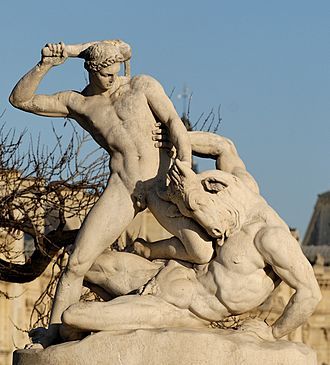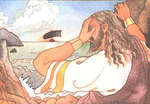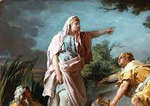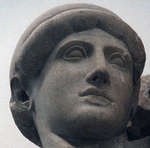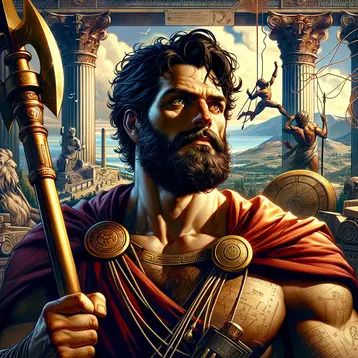
Theseus
The son of either Poseidon or Aegeus and Aethra, Theseus was widely considered the greatest Athenian hero, the king who managed to politically unify Attica under the aegis of Athens. Son of either Aegeus, the king of Athens, or Poseidon, the god of the sea, and Aethra, a princess, Theseus was raised by his mother in the palaces of Troezen. Upon reaching adulthood and finding out the identity of his father, he set out on a journey to Athens, during which he managed to outwit and overpower few notorious brigands: Periphetes, Sinis, Phaea, Sciron, Cercyon, and Procrustes. In Athens, after thwarting Medea’s attempts to eliminate him and capturing the Marathonian Bull, he volunteered to be one of the fourteen young Athenians sent to Crete as a sacrifice to the Minotaur so as to be able to kill the monster inside his Labyrinth. With the help of Ariadne who gave him a ball of thread to navigate himself inside the maze, Theseus managed to find and slay the Minotaur, after which he set sail back to Athens. There he ruled admirably for many years before an unsuccessful attempt (taken with his friend Pirithous) to abduct Persephone from the Underworld resulted in his deposition and, consequently, treacherous murder by Lycomedes of Scyros.
Theseus in Troezen: Foreshadowings of a Hero
The night Theseus was conceived, his mother Aethra slept with Aegeus, the king of Athens, and Poseidon, the god of the sea. Whoever his father had been, Theseus’ exceptional parentage was evident even in his early years. Soon after Theseus reached adulthood, Aethra sent him to Athens.
The Story of Theseus’ Birth
Even after two wives – Meta and Chalciope – Aegeus, the esteemed king of Athens, was still childless. Fearing the intentions of his three brothers, he headed off to Pythia to learn from the Oracle if he will ever produce a male heir. As always, the advice was all but straightforward: “The bulging mouth of the wineskin, o best of men, loose not until thou hast reached the height of Athens.” Aegeus didn’t understand any of this and sorrowfully set out on a journey back home. On his way to Athens, however, he did make one stop: calling at Troezen, he didn’t miss the chance to ask its king Pittheus if he would help him decipher the Oracle’s ambiguous reply. Pittheus, wise as he famously was, understood it perfectly, but chose to use the knowledge to his benefit: wishing for a nephew with Aegeus’ blood, he got his guest drunk and then introduced him to his daughter Aethra; Aegeus slept with her, a few hours before Poseidon, the mighty god of the sea, did the same. Nine months later, Aethra gave birth to a beautiful child: Theseus.
Heracles’ Lion Skin
Whether the son of a god or an exceptional mortal, Theseus was discernibly unlike his peers even as a child, outshining them in every category. One time, when Heracles visited Pittheus’ kingdom and took off his lion-skin before sitting at the dinner table, the children of the palace, mistaking it for a real lion, all fled in fear and alarm. Theseus calmly took an ax and attacked the skin; even back then, watching the scene with eyes full of love and awe, Aethra already knew what she was supposed to do in few years’ time.
The Sword and the Sandals
Because, you see, before Aegeus left Troezen, he hid his sword and a pair of sandals under a great rock. “If you bore a son in nine months,” he told Aethra, “and if he is able to lift this rock once he reaches manhood – then send him to Athens with this sword and these sandals, for then I’d know that he is, indeed, my son, the future king of Athens.” When the time came, Aethra led Theseus to the rock and relayed to him his father’s message. Theseus lifted the rock with ease and, equipped with Theseus’ tokens of paternity, hit the road to Athens.
On the Road to Athens
Sending him off to Athens, Aethra begged Theseus to travel by sea and, thus, bypass all the dangers which, by all accounts, lay on the land-route ahead of him. Theseus, however, wanted to earn himself a reputation worthy of a formidable hero before meeting his father. And by the time he reached Athens, he had vanquished so many famous villains – each with a memorable modus operandi – that people were already eager to compare him to his childhood idol, Heracles.
Periphetes, the Club-Bearer
Wielding a bronze club, Periphetes haunted the road near Epidaurus, threatening to savagely beat any traveler daring to cross paths with him. But Theseus wasn’t just any traveler: before Periphetes could realize, he managed to grab the club out of his hands and beat him to death with his own weapon. Emulating Heracles’ actions (who barely slipped out of the skin of the Nemean lion after completing his first labor), Theseus appropriated Periphetes’ club and, soon enough, it became the most recognizable piece of his equipment.
Sinis, the Pine-Bender
Before leaving Peloponnese, Theseus happened upon Sinis, the Pine Bender, so called because of his notorious habit of tying casual travelers to bent-down pine trees, which, upon release, instantaneously tore in two anyone unfortunate enough to be caught by this brutish bandit. However – and somewhat expectedly – Sinis was no match for Theseus: once again, the Athenian hero prevailed using his enemy’s own method of destruction.
Phaea, the Crommyonian Sow
An offspring of Typhon and Echidna, the Crommyonian Sow was either a huge wild pig which troubled the lands around Corinth and Megara or a vicious female robber nicknamed “The Sow” because of her appearance and vulgar manners. Either way, Theseus had no problems dealing with her as well.
Sciron, the Feet-Washer
Not much further, on the rocky coastal road of the Isthmus of Corinth, Theseus encountered Sciron, a mighty brigand who would force passing travelers to wash his feet – only so that he is able to kick his kneeling victims off the cliffs into the sea where a giant sea turtle waited to devour them. Recognizing the danger, once he bent down, Theseus grabbed Sciron by his foot, lifted him up, and then hurled him into the sea. The turtle got its meal either way.
Cercyon, the Wrestler
Compared to the other five malefactors Theseus came across on his road to Athens, Cercyon of Eleusis was somewhat old school: he challenged passersby on a win-or-die wrestling match. Not a good idea when your opponent is Theseus! Needless to say, it was Cercyon who got the wrong side of the proposed bargain. Or as a Greek poet put it in both humorous and oblique manner: Theseus “closed the wrestling school of Cercyon.”
Procrustes, the Stretcher
At first sight, Procrustes seemed a kind man: he offered his house as a shelter to any traveler in need who happened to run into him. The house had two beds, a short and a long one. However, once the ill-fated traveler would choose and lay down in one of them, Procrustes made sure to make him fit the bed (not the other way around), either by using his infernal apparatus to elongate his extremities or by hammering down his length. As it should be evident by now, Theseus eventually dealt with his host in the same way he did with his guests. And even though we don’t know which one of Procrustes’ two beds spelled the end for Procrustes, it couldn’t have been a pleasurable experience either way.
Theseus in Athens: An Unwelcomed Guest
In Athens, Theseus was quickly recognized by Medea, the wife of his father, Aegeus. So, before Aegeus could make out Theseus’ identity, the hero had to prove his worth and capture the Marathonian Bull.
Aegeus and Medea
When Theseus arrived in Athens, he had the misfortune of being recognized by the wrong person: not by his father Aegeus, but by his then-wife, the sorceress Medea. Obviously, Medea didn’t want Aegeus to be succeeded in his throne by a son from a previous marriage, so she resolved to kill Theseus. She had no problem convincing Aegeus to her side, since the Athenian king still feared that he would be killed by one of his brother’s sons or, even worse, by an outsider. So, soon after arriving in Athens, Aegeus sent Theseus to capture the Marathonian Bull.
The Marathonian Bull
Now, the Marathonian Bull is actually the same bull Heracles managed to capture for his seventh labor. Formerly known as the Cretan Bull, the creature was either set free by Heracles or escaped from Tiryns by itself. After traversing the Isthmus of Corinth, it arrived at Marathon and bothered its inhabitants for years before Theseus finally managed to master it. After showing it to Aegeus and Medea, Theseus killed the Bull and sacrificed it to Apollo.
The Cup of Poison: Theseus Recognized
Medea didn’t expect Theseus to emerge victorious from his clash with the Marathonian Bull; nevertheless, she did have a Plan B, which included a feast and a cup of poison. Fortunately, barely a second before the poison touched Theseus’ lips, Aegeus recognized his sword and his sandals – and, moreover, Medea’s cruel intentions. Two proclamations followed, one naming Theseus as Aegeus’ rightful successor to the throne, and another banishing Medea from Athens forevermore.
Theseus in Crete
Soon after Theseus’ return to Athens, it was due for Aegeus to pay the third yearly tribute to Minos, the king of Crete. Namely, in recompense for the death of Minos’ son, Androgeus – once savagely killed by the Athenians out of jealousy and envy – Athens obliged to regularly send fourteen of its noblest young men and women to Crete, where each of them was destined to meet the same end: to be thrown into Daedalus’ Labyrinth and be devoured by the monstrous half-man half-bull Minotaur.
Ariadne and the Minotaur
Always in pursuit for fame and glory – and now deeply despaired over the gruesome fate awaiting the innocent young Athenians – Theseus resolved to do something about this. So, when the time came, he volunteered to go to Crete, where Ariadne, Minos’ beautiful daughter, fell in love with him upon arrival, the very moment she laid eyes on the muscular Athenian prince. Determined to assist him, she begged Daedalus to tell her the secret of the Labyrinth, which, eventually, the old craftsman agreed to. And when the time came for Theseus to enter the Labyrinth, Ariadne gave him a ball of thread (provided by Daedalus) that was supposed to help him navigate himself inside the structure and guide him safely out of it.
Comforted by the fact that he would always be able to find his way out, Theseus delved deep into the Labyrinth and found the Minotaur haunting its innermost depths. As beastly as he was, the Minotaur was no match for Theseus’ strength and determination: after a brief fight, the Athenian killed the monster and followed the thread back to safety.
Theseus and Ariadne
Now, Theseus had promised Ariadne to marry her before even making his first step inside the Labyrinth; and, that’s the first thing he did after coming out of it safe and sound. After the brief marital ceremony, he took Ariadne with him and, together with the other young Athenians, left Crete. Strangely, his marriage with Ariadne lasted no more than just a few days: as soon as his ships reached the island of Dia (later called Naxos), Theseus left the sleeping Ariadne behind him and sailed away. Some say that he did this because he had fallen in love with another girl in the meantime (Panopeus’ daughter Aegle); others – because he had no choice but to obey the will of Dionysus who wanted Ariadne for himself. The latter claim that the god arrived on the island of Dia just moments after Theseus had left it, and swiftly carried Ariadne off in his chariot to be his beloved and immortal wife.
Theseus, the King of Athens
A Broken Promise
Before setting off for Crete, Theseus had promised his father that, if he survived the Minotaur, he would change his ship’s black sail to a white one. Thus, Aegeus would be able to discern from some distance whether his son was still alive. Unfortunately, he either forgot his promise altogether or was too distraught to make the change on time. Watching from a vantage point, Aegeus couldn’t bear the sight he had most dreaded to see, so he hurled himself to his death straight away.
Unification of Attica
Theseus was now the king of Athens – and what a king he was! The list of his achievements is rather lengthy, but most authors agree that the greatest among them was the successful political unification (synoikismos) of Attica under Athens. In addition, Theseus is credited with instituting the festival of the Panathenaea and the Isthmian Games.
Phaedra and Hippolytus
From his expedition against the Amazons (see below), Theseus brought back to Athens one of their queens – either Antiope or Hippolyte – and she subsequently bore him a son, Hippolytus. After some time, he grew bored with his wife, so he found himself another: strangely enough, none other than Ariadne’s sister, Phaedra! Phaedra gave Theseus two children – Acamas and Demophon – but, then, to her surprise, fell madly in love with her stepson, Hippolytus. After Hippolytus rejected her advances, she told Theseus that he had tried to rape her. Theseus cursed Hippolytus and, before long, his curse came true: Hippolytus was dragged to death by his horses. Either out of grief or because her treachery was exposed in the meantime, Phaedra hanged herself.
Theseus and Pirithous
While a king, Theseus befriended the king of the Lapiths, Pirithous. He shared numerous adventures with him, the most famous among them being the hunt for the Calydonian Boar, the Centauromachy, and an expedition among the Amazons, from which – to the utter dismay of the women warriors – both returned with new wives. Some years later, the two friends attempted a similar raid in the Underworld, but the abduction of Hades’ wife, Persephone, didn’t go according to plan: instead of getting Persephone out of there, Theseus and Pirithous remained stuck inside, fixed immovable to two enchanted seats. On his way to capturing Cerberus, Heracles noticed and recognized the heroes; even though, with some effort, he managed to free Theseus, the earth shook when he tried to do the same with Pirithous; so, Heracles had no choice but to leave Pirithous in the Underworld forevermore.
The Death of Theseus
Once freed from the Underworld, Theseus hurried back to Athens only to find out that the city now had a new ruler: Menestheus. He fled right away for refuge to Lycomedes, the king of the island of Scyros. A tragic mistake, since Lycomedes was a supporter of Menestheus! After a few days of feigned hospitality, Lycomedes took the unsuspecting Theseus on a tour of the island; the second they reached its highest cliff, he violently pushed Theseus to his death.
The Aftermath
Generations passed without much thought being given to Theseus. Then, during the Persian wars, Athenian soldiers reported seeing the ghost of Theseus, clad in bronze armor and in full charge, and came to believe that he was responsible for their victories. The Athenian general Cimon received a command from the Oracle at Delphi to find Theseus' bones and return them to Athens. He did so, and the gigantic skeleton of Theseus was reburied in a magnificent tomb in the heart of Athens, which thereon served as a sanctuary for the defenseless and the oppressed of the world.
Theseus Sources
Mentioned in both the “Iliad” and the “Odyssey,” Theseus is an important character in Euripides’ play “Hippolytus.” Ovid recounts his conflict with Medea and the Minotaur in the seventh and the eighth book of his “Metamorphoses.” The first biography narrated in Plutarch’s influential “Parallel Lives” is that of Theseus.
See Also: Theseus Adventures, Minotaur, Aegeus, Aethra, Cretan Bull, Ariadne, Phaedra, Pirithous, Calydonian Boar
Theseus Video
Theseus Q&A
Theseus Associations
Link/Cite Theseus Page
Written by: The Editors of GreekMythology.com. GreekMythology.com editors write, review and revise subject areas in which they have extensive knowledge based on their working experience or advanced studies.
For MLA style citation use: GreekMythology.com, The Editors of Website. "Theseus". GreekMythology.com Website, 08 Apr. 2021, https://www.greekmythology.com/Myths/Heroes/Theseus/theseus.html. Accessed 26 April 2024.

